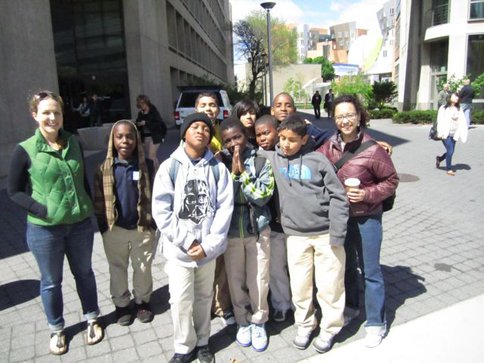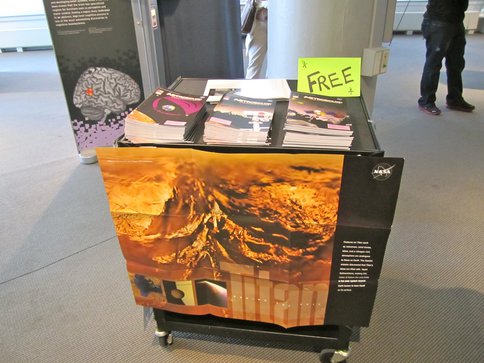2012 Annual Science Report
 Massachusetts Institute of Technology
Reporting | SEP 2011 – AUG 2012
Massachusetts Institute of Technology
Reporting | SEP 2011 – AUG 2012
EPO Activity: EPO Report on Cambridge Science Festival and Youth Astronomy Apprentice Program
Project Progress
Down to Earth Outer Space @ the MIT Museum as a part of the 2012 Cambridge Science Festival:
In collaboration with the MIT Youth Astronomy Apprenticeship program, we created and displayed a temporary museum exhibit on Astrobiology called Worlds Beyond: The Search for Life in the Universe. The exhibit was designed and built by the YAA apprentices: Boston Public High school students and recent BPS graduates now enrolled in community college in the Boston area. The exhibit was guided by Dr. Phoebe Cohen, YAA director an astronomer Dr. Irene Porro, and members of the MIT team including PI Roger Summons. The exhibit featured hands-on components relating to a wide array of astrobiology topics including extremophiles, exoplanet detection, the geology of Mars, the habitable zone, tools from the Curiosity rover, and the special properties of water. The exhibit was on display at the MIT Museum for 1 day during the Cambridge Science Festival in April 2012. The exhibit was accompanied by three invited speakers who spoke about black holes, the Curiosity Rover, and finding life on other planets. Over 500 people came through the museum and over 150 people attended the lectures.
Description of the event —
Saturday, April 28
10:00 a.m. – 4:00 p.m.
Down to Earth Outer Space
Discover space research at MIT! Hands-on activities and interactive displays will be available all day, with featured presentations at 11:00 a.m., 1:00 p.m. and 3:00 p.m. Explore new worlds in new ways—from the search for life in extreme environments and the exploration of Mars to the discovery of black holes with new technologies and x-rays from distant galaxies.
11:00 a.m.: Mike Nowak: “If black holes are black, then how do we see them? (Answer: sometimes we don’t!)”
1:00 p.m.: Matt DiCicco: “NASA’s new nuclear powered, rock-crushing, laser blasting Mars rover”
3:00 p.m.: Meredith Danowski: “From dusty galaxies to alien worlds- it really IS rocket science!”
The goals of the YAA project were twofold:
1) Educate and expose the public to the field of Astrobiology and to the research taking place within NASA’s NAI program.
2) Engage the Youth Astronomy Apprenticeship youth in the process of exhibit design and content development, educating them about Astrobiology, and helping to build their communication skills.
This year we also evaluated the impact of the YAA Astrobiology project on the interns themselves. Results from the surveys can be seen in the figures below – in general, the project exposed the interns to new ideas and new information, increased their desire for additional knowledge about science, and improved a variety of life and work skills.
Geological Timeline Walk:
Also as a part of the Cambridge Science Festival in April 2012, we displayed our popular to-scale Geological Timeline walk signs along the Charles River for 9 days. Each sign provides information on an event in earth or life history and the signs are spaced out to scale to give the public a better sense for the immensity of geologic time and the antiquity of life. This year we set up an online sign up sheet for teachers and afterschool instructors to bring their classes to the tour. Six classes signed up and got tours, ranging from Cambridge public school students from the local elementary school to students from the Prospect Hill Charter school and students at a Boston University english enrichment program. Tours were given by EPO Lead Cohen and other members of the MIT NAI team including graduate students, post docs, and faculty.
Stories of Science Communication Workshop:
In collaboration with the Cambridge Science Festival, EPO lead Phoebe Cohen co-faciliated a workshop for graduate students in the Boston area on how to effectively communicate their research to public audiences. More information on the workshop can be found here:
http://csfworkshop.eventbrite.com/
Attendees had to prepare a 5 minute presentation on a topic of their choice and then were critiqued by Cohen and Cambridge Science Festival director P.A. D’Arbellof. The winners of the NASA Astrobiology FameLab competition were used as examples and guides for the participants.
YAA apprentices were asked: As a result of your participation in the YAA partnership, do you agree or disagree that you have changed the way you approach the tasks described in the following statements:
Students were asked: Please tell us about some of the positive aspects of your YAA Astrobiology internship this past summer. What did you learn, what was fun and interesting to you, what do you still remember the most?
EPO Lead Phoebe Cohen and Post Doc Lindsay Hayes after giving a tour of the Cambridge Science Festival Geological Timeline walk to a group of 5th graders from Prospect Hill Academy, a local charter school.
Former MSL engineer Matt DiCicco shows the landing site of Mars rover Curiosity during our Cambridge Science Festival Space Day event at the MIT Museum



